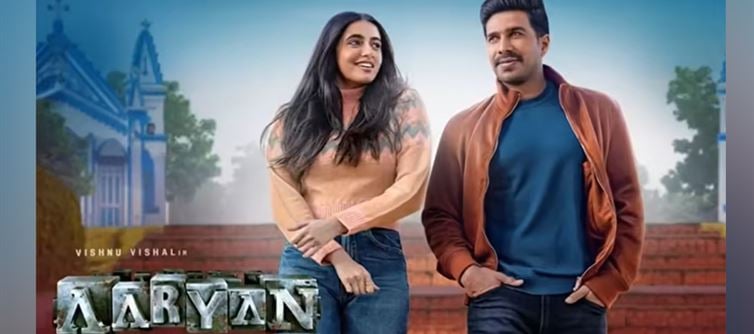
Story:
Aaryan opens with a premise so audacious that it immediately hooks you. A failed writer, Azhagar (Selvaraghavan), hijacks a live television broadcast, announcing his five-part “murder story.” He declares that his suicide will be the first killing—and then shoots himself on air. That shocking act sets the tone for a grim, cerebral thriller that explores obsession, art, and revenge from beyond the grave. With the killer already dead, the story shifts to DCP Nambi (Vishnu Vishal), a cop torn between duty and a collapsing marriage. Nambi soon realizes he isn’t solving murders in real time—he’s merely catching up with a narrative already written by a ghost.
As the days unfold, each killing follows a pattern: an unsung hero from society—a nurse, a soldier, an activist—is murdered according to Azhagar’s prophetic blueprint. The idea that death is being orchestrated through the pages of a dead man’s script gives the film its eerie heartbeat. But as the mystery deepens, so does the moral ambiguity—was Azhagar insane, or simply desperate to make his art immortal?
Performances:
Selvaraghavan, in his limited screen time, is magnetic. His haunted eyes and unsettling calm make Azhagar’s madness believable and tragic. Even after his exit, his presence lingers like a ghost through video messages and recordings—proof of how impactful his short stint is. vishnu vishal delivers one of his more composed performances as DCP Nambi—sturdy, controlled, and believable as a man driven by guilt and obsession. shraddha srinath shines as a sharp, morally grey tv host caught in the web of the story she once aired. Maanasa Choudhary, though brief in appearance, adds emotional weight as Nambi’s estranged wife, grounding the thriller with a touch of realism.
Technicalities:
Director prasanna Bala crafts an atmosphere of impending doom with moody lighting and cold, muted tones. The cinematography by Krishnan venkatesh smartly contrasts the claustrophobia of studio spaces with the sprawling emptiness of crime scenes. Yuvan shankar Raja’s background score is understated but effective—it doesn’t oversell the tension but rather lets silence speak. The editing by Raymond Derrick Crasta keeps the film tight, though the first act feels slightly indulgent. Dialogues are crisp, particularly Azhagar’s philosophical rants about creativity and death.
Analysis:
Aaryan is an idea-first thriller—its most fascinating component is its concept, not necessarily its execution. The premise—that a dead man continues to dictate life and death—is almost poetic. The writing, however, sometimes struggles to balance the pulpy thrills with its intellectual ambition. The social commentary—on how society ignores its everyday heroes until tragedy strikes—feels shoehorned into the narrative rather than earned. Yet, the second half redeems the unevenness, transforming into a race-against-time procedural with real bite.
The cat-and-mouse game between the dead writer and the living cop is the film’s strongest stretch. Some moments evoke Se7en and Memories of Murder, yet Aaryan never feels derivative—it finds its own identity in its moral greyness and meta-commentary on storytelling itself.
What Works:
• A brilliant opening sequence with Selvaraghavan’s live-TV suicide
• Inventive “killer-is-dead” premise and its psychological layers
• vishnu Vishal’s grounded performance
• Sharp cinematography and a tense second half
• A satisfying, well-staged finale
What Doesn’t:
• A sluggish first act post-suicide• A forced social message that dilutes the central thriller
• Some predictable investigative beats
• Occasional exposition-heavy dialogues
Bottom Line:
Aaryan is a thinking man’s thriller disguised as a cop story. It begins with a bang—literally—and while it stumbles midway, it regains balance with its sharp second half and a haunting finish. Not flawless, but definitely fascinating.
🎬 Rating: ⭐️⭐️⭐️✨ (3.5/5)
💥 India Herald Verdict Meter: 73% – Smart, tense, and morally twisted. A thriller that dares to let death take the pen.




 click and follow Indiaherald WhatsApp channel
click and follow Indiaherald WhatsApp channel